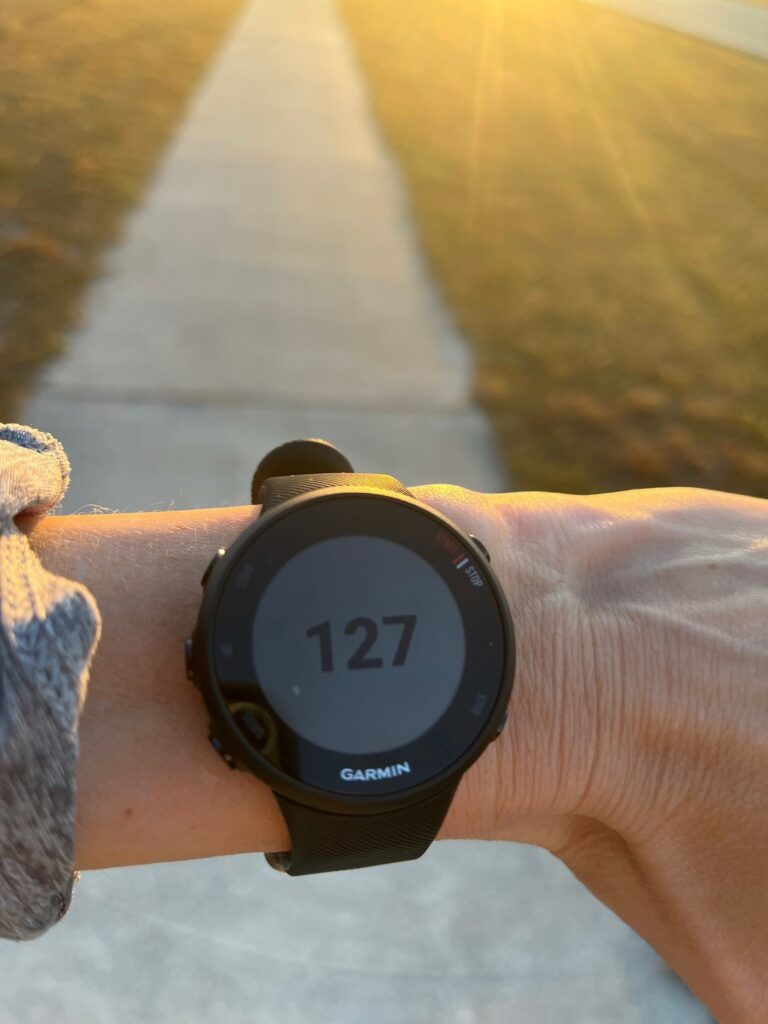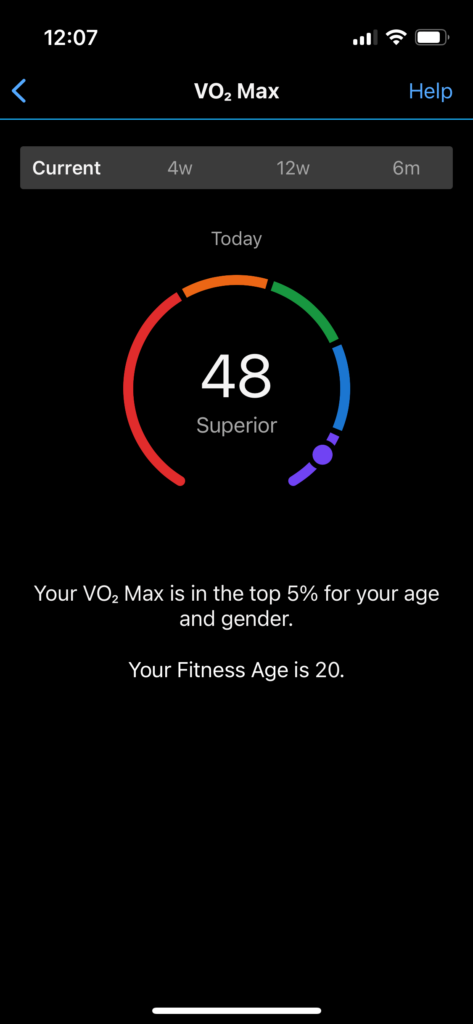
Do you live at a low elevation and wonder how to run a race at a higher altitude? I’ve recently completed a high altitude run training at sea level and found heart rate training to be key. Through experience and research, I’ve learned some tips that I share which may also help you succeed.
As a general rule, targeted heart rate training can optimize training for high altitude running. It focuses on developing the efficiency of the heart and lungs which is key when less oxygen is available. In addition, heart rate training improves physical and mental endurance which is needed for finishing at high altitudes.
You will need patience, perseverance, and determination when training to run a higher elevation race. Being prepared mentally and physically will be crucial and heart rate training is one of the best ways to do both. Read on for the best strategies and tips to help you succeed.
What is considered high altitude?

High altitude for athletic performance purposes is typically considered to be anything above 5,000 ft or 2,400 m. This is when athletic performance begins to be impacted and some may experience symptoms of altitude sickness.
According to the Cleveland Clinic nearly half of people who climb above 8.000 ft (3,840 m) will experience altitude sickness. Each person will respond differently to different elevations, but the greater the change in elevation the more likely you will be impacted.
What does high altitude do your heart rate and body?
The air at higher elevations has less oxygen and reduced atmospheric pressure. Both factors put additional stress on your heart and body that will impact athletic performance to some degree.
In general, breathing and heart rate increase at higher altitudes to compensate for less oxygen being available with every breath. As your heart and lungs work harder your pace will be slower and the effort will feel harder.
At higher elevations, the risk of dehydration is greater which can negatively impact the body and heart. The air is usually drier and windier making hydrating more challenging. You lose more fluids with an increased respiratory rate and lower air pressure increases fluid evaporation from your skin.
The most serious impact you may experience is altitude sickness, which can be a life-threatening condition. There are varying degrees of symptoms, but all should be closely monitored, especially if you have a heart condition. Altitude sickness symptoms include:
- Light-headedness
- Dizziness
- Nausea
- Headache
- Shortness of breath
- Loss of appetite
- Problems sleeping
Benefits of heart rate training for a high-altitude race
Optimize running and running performance. Training in different zones targets different adaptations such as building a strong aerobic foundation and improving endurance. It can also increase your ability to sustain hard effort over a long distance which is needed in a higher altitude environment.
Develop the aerobic system. Heart rate training at sea level can increase the efficiency of your heart and lungs. The better your aerobic system, the more efficient your body will be at transporting and delivering oxygen at higher elevations.
Efficient energy utilization. Heart rate training can help your body be more efficient at using your energy sources such as fat for fuel. At high altitudes, the reduced oxygen can limit the availability of carbohydrates. Teaching the body to use fat for fuel enhances your endurance and prolongs energy availability at higher altitudes.
Improved mental endurance. Training at sea level by heart rate zone and not pace is good preparation for higher altitude running. Maintaining a steady pace within a target heart rate zone takes mental toughness. Overall, mental resilience is seen in better focus, pacing and the ability to push through discomfort during high altitude runs.
Effective training progression. By monitoring and tracking your heart rate, you can gradually increase the intensity, duration, and frequency while staying in your optimal heart rate zones. This will help prevent overtraining and optimize your readiness for the higher altitude.
Better adaptation to altitude. Improving aerobic capacity, energy utilization, and mental endurance through heart rate training, can enhance the body’s ability to adapt more efficiently when transitioning to higher elevations.
Determine baseline heart rate for training zones
To train by heart rate you will need to know your max heart rate which is used to calculate your training zones. Your resting heart rate can be used to track your heart’s efficiency and to prevent overtraining.
To determine your max heart rate (MHR), you can perform either a field test or use a calculation. The field test is the most accurate, but it is difficult and may not be advisable for those with certain health or heart conditions.
- Field test for determining max heart rate
Warm up for 10-15 minutes. Perform 3 repeats running hard for 2-3 minutes and resting 2-3 minutes. With each repeat increase your running speed until you are running all out on the third repeat. After the last repeat, check your max heart rate.
- Max heart rate (MHR) formula
The most common and popular method for calculating max heart rate is:
MHR = 220 – Age
The above calculation is only an estimate since it is only based on age and no other relevant factors. The calculation of max heart rate can be off by as much as 10-20 beats.
Heart rate zones for training
There are five basic zones of heart rate training, but there can be more depending on the program used. Almost all zones are calculated as a percentage of your max heart rate, but some factor in resting heart rate.
Below are typical heart rate zones based on your max heart rate. These ranges tend to be the easiest to calculate and follow.
| Heart rate zone ( 5 zone plan) | Cardio Workout | Run Type | % Max Heart Rate |
| 1 | Easy | Recovery/Warm-ups | 50% – 60% |
| 2 | Aerobic | Easy run / Long Run | 60% – 70% |
| 3 | Aerobic | Tempo Run | 70% – 80% |
| 4 | Anaerobic threshold | Threshold Run | 80% – 90% |
| 5 | Anaerobic Speed training | Interval repeats | 90%-100% |
Calculations using resting heart rates such as Karvonen have smaller ranges for each zone. Below is a sample of ranges based on several different resting and max heart rates.
| Heart rate zone ( 5 zone plan) | Cardio Workout | Run Type | % Max Heart Rate |
| 1 | Easy | Recovery/Warm-ups | 64% – 71% |
| 2 | Aerobic | Easy run / Long Run | 71% – 78% |
| 3 | Aerobic | Tempo Run | 78% – 85% |
| 4 | Anaerobic threshold | Threshold Run | 85% – 93% |
| 5 | Anaerobic Speed training | Interval repeats | 93%-100% |
The point where the body transitions from aerobic to anaerobic is not an exact percentage as there are many other factors to consider. The exact percentage will be different for each individual so the above are only guides.
Understanding heart rate training zones
Following a plan that outlines training within specific heart rate zones has many benefits as mentioned above. Each zone encourages and strengthens different adaptations that will be specifically needed for completing a run at high altitude.
Below is a list of each zone and how each improves performance.
| Zone | Intensity | Percentage of Max HR | Run Type | Purpose (how enhances performance) |
| Zone 1 | Very light | 50–60% | Recovery Workout or Warm-up | Increases overall fitness and encourages blood flow to the muscles |
| Zone 2 | Light | 60–70% | Easy Run/Long Run | Builds aerobic engine and fat-burning engine |
| Zone 3 | Moderate | 70–80% | Tempo run | Improves endurance and raises aerobic metabolism |
| Zone 4 | Hard | 80–90% | Threshold run | Improves endurance by raising lactate threshold |
| Zone 5 | Maximum | 90–100% | Intervals/Speed workouts | Improves VO2max, running speed, and running economy |
To train for a high altitude run at sea level you will want to increase your aerobic capacity, endurance, and stamina. Optimizing your VO2Max, which is a measure of how efficiently your body uses oxygen, will be key to improving all.
Improving your VO2max, aerobic base, endurance, and stamina can be accomplished with a polarized heart rate training plan. This approach has the bulk of your training (80-90%) in zone 2 with a small percentage in zone 4. See my article here for more information on how many elites use this type of training.
Zone 3, also known as the grey zone, may provide the least benefit and is usually avoided by many coaches and elite athletes. It’s generally thought that the intensity is not high enough to trigger aerobic adaptations to optimize the cardiovascular system. On the other hand, the zone is not low enough to encourage recovery for preventing injury and overtraining.
For more tips on using the different zones to improve your running overall see my article here.
Training strategies for a high altitude run
Build your aerobic engine. You will need a strong cardiovascular system for the stresses and strains of a high altitude run. Try to spend 70-85% of your weekly running time in Zone 2 to build your aerobic base and endurance.
Improve your VO2Max, running economy, and power. Spend the remainder of your running time in the higher intensity zones, targeting zone 4. Incorporating a very small amount in zone 5 will also prove beneficial as you learn to push beyond comfortable limits.
Run hill repeats or on a treadmill with an incline. Running hill repeats on the same terrain as the expected run is best. However, many coastal areas lack any hills or inclines to train on. Use a treadmill with an incline to help strengthen the back of the legs and ankles. Keep in mind it may be more efficient and faster to hike or walk rather than running on steeper inclines.
Strength training is extra important! Running at a higher altitude especially with steep terrain will be hard. Strength training will prevent injury during your training block and best prepare the body for rigors and intensity ahead. Building strong muscles can help compensate for any training you are not able to replicate at sea level.
How much training you should be doing will depend on the distance and terrain of the planned run. Setting a realistic goal and over preparing is the best recipe for success and enjoyment. Training sensibly with sufficient rest and recovery is just as important so you can arrive at the starting line healthy.
Monitoring heart rate during training and racing

Monitoring your heart rate during the training cycle will optimize your training and keep you healthy. During the race, it will also help ensure you can finish and finish strong.
Running both long and short distances with a target heart rate is good physical and mental training. It takes self-control, patience, and grit to stay within the target heart rate zones.
Learning to dial it back and stay in zone 2 will allow you to increase you training load as safely as possible. It’s best to focus on time on your feet rather than mileage to build endurance and mental toughness.
Besides easing off, pushing yourself harder for the higher intensity training is just as important. A high-altitude run is going to be hard. Training your body to push beyond the normal comfort zones may be the difference between success and failure.
Monitoring your heart rate during the run will be vital to ensure you can finish. Most will have higher heart rates due to the both the terrain and lack of oxygen at higher elevations. Keeping an eye on your heart rate rather than pace is the best way to ensure you reserve enough energy to finish.
Nutrition, hydration, and heart rate for higher altitudes runs

Your heart rate can be the first sign that you are over-training, have an illness coming on, or are not fueling and hydrating sufficiently. An elevated heart of 5-10 beats is usually a sign the body needs more rest.
Dehydration, an electrolyte imbalance, or poor nutrition can all impact your body’s ability to recover contributing to an elevated heart rate. In addition, an electrolyte imbalance and dehydration can also lead to an irregular heart rate. See my article here if you experience sudden drop in heart rate during your run.
Good nutrition and proper hydration support the body’s ability to recover from the hard training needed for high altitude runs. Monitoring your resting heart rate and heart rate during your runs is an excellent way of ensuring you resting, fueling, and hydrating sufficiently.
During your run, you will also likely require more calories at higher elevations due to the extra demands on the body. Be sure to consume extra carbohydrates both prior to and during the run for optimal performance.
Drink more than you normally would as higher elevations cause you to lose more fluids. In addition, you may not feel thirsty due to the cooler temperatures, but you need to stay well hydrated.
Mental Preparation and Altitude challenges

Running at high altitude is going to be hard. Heart rate training helps prepare you mentally for the resilience and perseverance you will need.
On race day, be sure to listen to your body and adjust your pace to stay within a target heart rate zone. Although your pace will be slower and the effort will feel harder, this is the best way to stay safe and finish.
It’s impossible to predict how your body may respond at high altitude so be alert for signs of altitude sickness. Mentally prepare yourself for the fact that your body may have other plans despite your best efforts.
How I trained at sea level and what I would do differently
Link here to the video.
I recently completed an ultra-marathon at the Matterhorn in the Swiss Alps training exclusively at sea level. It was beyond beautiful, as hard as I anticipated, and one of the best experiences of my life!
The secret to my success as a newer runner (only 6 years under my belt) was the heart rate training. I did lots of low heart rate runs, one higher intensity run each week, and strength training twice a week. In addition, I focused on getting my VO2max as high as I could in anticipation of lower oxygen levels.
Below was my VO2Max in weeks before and after the run.

With no hills to train, I used the treadmill with the incline sparingly due to boredom. In retrospect, I should have done more on the treadmill incline and more strengthening of the hamstrings. The steep incline really took its toll on my hamstrings, ankles, and my pace.
Overall, the race was everything I imagined and more! I had the most amazing time and met some incredible people. Whenever I got intimidated and weak in the knees, I reminded myself that that Mount Everest is conquered one step at a time.
Closing thoughts for achieving success in high altitude running
- Be sure to choose a high altitude run you are excited about with enough time to train properly (I set mine 6 months out).
- It is going to be hard so over-train and mentally prepare yourself for major discomfort.
- Track your progress including your resting heart rate, VO2Max, and heart rate at different paces.
- Visualize the run during your training. It will bring you much joy and build your excitement.
- Two months out really focus on adding more strength training.
- One month out be injury and sickness conscious so you arrive at the starting line healthy.